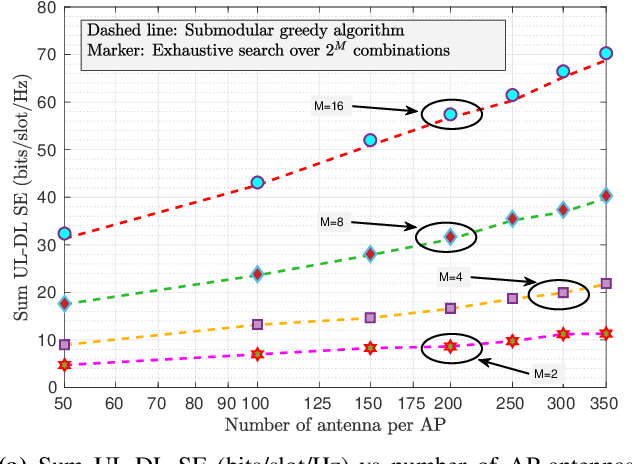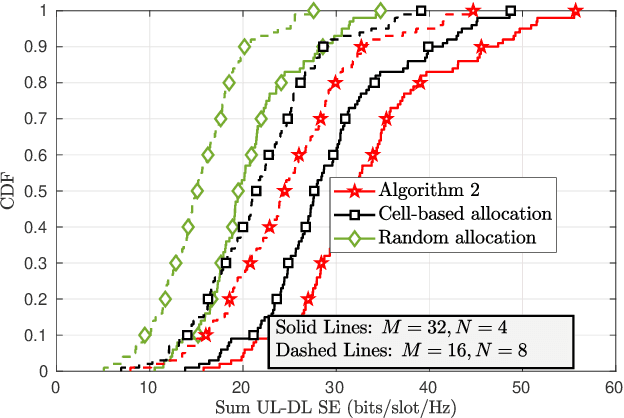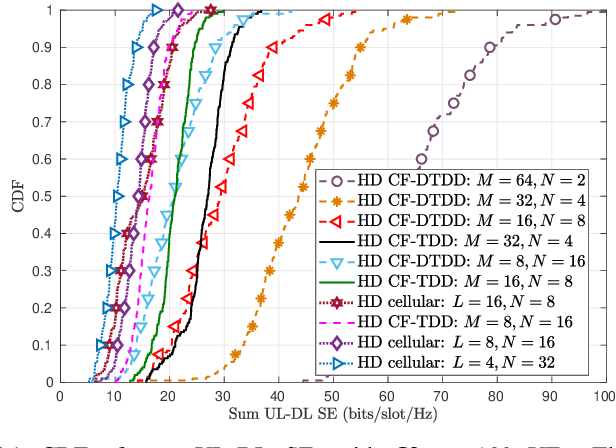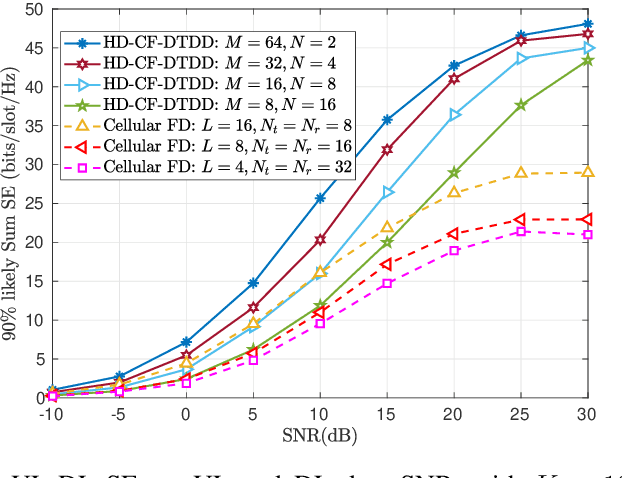Anubhab Chowdhury
Half-Duplex APs with Dynamic TDD vs. Full-Duplex APs in Cell-Free Systems
Sep 04, 2023Abstract:In this paper, we present a comparative study of half-duplex (HD) access points (APs) with dynamic time-division duplex (DTDD) and full-duplex (FD) APs in cell-free (CF) systems. Although both DTDD and FD CF systems support concurrent downlink transmission and uplink reception capability, the sum spectral efficiency (SE) is limited by various cross-link interferences. We first present a novel pilot allocation scheme that minimizes the pilot length required to ensure no pilot contamination among the user equipments (UEs) served by at least one common AP. Then, we derive the sum SE in closed form, considering zero-forcing combining and precoding along with the signal-to-interference plus noise ratio optimal weighting at the central processing unit. We also present a provably convergent algorithm for joint uplink-downlink power allocation and uplink/downlink mode scheduling of the APs (for DTDD) to maximize the sum SE. Our numerical results illustrate the superiority of the proposed algorithms over several benchmarks and show that the sum SE with DTDD can outperform an FD CF system with similar antenna density. Thus, DTDD combined with CF is a promising alternative to FD that attains the same performance using HD APs, while obviating the burden of intra-AP interference cancellation.
Can Dynamic TDD Enabled Half-Duplex Cell-Free Massive MIMO Outperform Full-Duplex Cellular Massive MIMO?
Oct 19, 2021



Abstract:We consider a dynamic time division duplex (DTDD) enabled cell-free massive multiple-input multiple-output (CF-mMIMO) system, where each half-duplex (HD) access point (AP) is scheduled to operate in the uplink (UL) or downlink (DL) mode based on the data demands of the user equipments (UEs). The goal is to maximize the sum UL-DL spectral efficiency (SE). We theoretically establish the sub-modularity of the sum SE, which allows us to develop a new, low complexity, greedy algorithm for the combinatorial AP scheduling problem, with guaranteed optimality properties. We also consider pilot sequence reuse among the UEs to limit the channel estimation overhead. In CF systems, all the APs estimate the channel from every UE, making pilot allocation problem different from the cellular case. We develop a novel algorithm that iteratively minimizes the maximum pilot contamination across the UEs. We compare our solutions, both theoretically and via simulations, against a full duplex (FD) multi-cell mMIMO system. Our results show that, due to the joint processing of the signals at the central processing unit, CF-mMIMO with dynamic HD AP-scheduling significantly outperforms cellular FD-mMIMO in terms of the sum SE and 90% likely SE. Thus, DTDD enabled HD CF-mMIMO is a promising alternative to cellular FD-mMIMO, without the cost of hardware for self-interference suppression.
 Add to Chrome
Add to Chrome Add to Firefox
Add to Firefox Add to Edge
Add to Edge